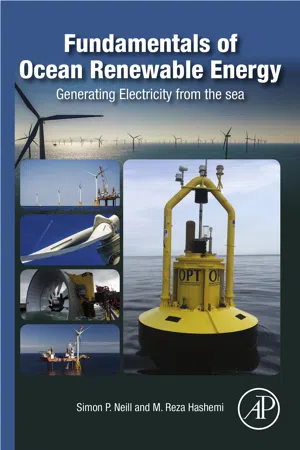
Fundamentals of Ocean Renewable Energy
Generating Electricity from the Sea
- 336 pages
- English
- ePUB (mobile friendly)
- Available on iOS & Android
Fundamentals of Ocean Renewable Energy
Generating Electricity from the Sea
About this book
Fundamentals of Ocean Renewable Energy: Generating Electricity from the Sea presents the basic concepts of mechanics and introduces the various technical aspects of ocean renewable energy. Contents follow a logical sequence, starting with hydrodynamics and then separately examining each conversion technology, with special focus on tidal energy, offshore wind and wave energy, as well as current and ocean thermal energy conversion (OTEC). The authors explore key topics for resource characterization and optimization, such as monitoring and measurement methods and ocean modeling. They also discuss the sustainability, planning, integration and distribution challenges for the implementation of these technologies, including co-location with other systems.Finally, case studies of ocean energy sites and devices allow for a better understanding of how ocean energy conversion works in real-world settings. This book is an invaluable resource for students at graduate and senior undergraduate level engineering (ocean, mechanical, and civil) and oceanography with prior knowledge of fluid mechanics and mechanics of materials.- Presents the fundamental physics and theory behind ocean energy systems, covering both oceanographic and engineering aspects of ocean energy- Explores the most widely adopted conversion technologies, including tidal, wave, offshore wind, ocean thermal and currents
Frequently asked questions
- Essential is ideal for learners and professionals who enjoy exploring a wide range of subjects. Access the Essential Library with 800,000+ trusted titles and best-sellers across business, personal growth, and the humanities. Includes unlimited reading time and Standard Read Aloud voice.
- Complete: Perfect for advanced learners and researchers needing full, unrestricted access. Unlock 1.4M+ books across hundreds of subjects, including academic and specialized titles. The Complete Plan also includes advanced features like Premium Read Aloud and Research Assistant.
Please note we cannot support devices running on iOS 13 and Android 7 or earlier. Learn more about using the app.
Information
Introduction
Abstract
Keywords
1.1 The Global Energy Mix


| Country | kWh per Capita |
|---|---|
| Iceland | 54,799 |
| Norway | 23,326 |
| Canada | 15,519 |
| Qatar | 15,471 |
| Sweden | 13,870 |
| United States | 12,988 |
| United Arab Emirates | 10,904 |
| Australia | 10,134 |
| Saudi Arabia | 8741 |
| Japan | 7836 |
| France | 7374 |
| Russia | 6539 |
| Ireland | 5702 |
| United Kingdom | 5407 |
| Spain | 5401 |
| Chile | 3879 |
| China | 3762 |
| Iran | 2899 |
| Brazil | 2529 |
| Mexico | 2057 |
| Costa Rica | 1955 |
| Peru | 1270 |
| Indonesia | 788 |
| India | 765 |
| Pakistan | 450 |
| Bangladesh | 293 |
| Sudan | 159 |
| Nigeria | 142 |
| Ethiopia | 65 |
| Niger | 49 |
| South Sudan | 39 |

Table of contents
- Cover image
- Title page
- Table of Contents
- Copyright
- Quotes
- Preface
- Chapter 1: Introduction
- Chapter 2: Review of Hydrodynamic Theory
- Chapter 3: Tidal Energy
- Chapter 4: Offshore Wind
- Chapter 5: Wave Energy
- Chapter 6: Other Forms of Ocean Energy
- Chapter 7: In Situ and Remote Methods for Resource Characterization
- Chapter 8: Ocean Modelling for Resource Characterization
- Chapter 9: Optimization
- Chapter 10: Other Aspects of Ocean Renewable Energy
- Index